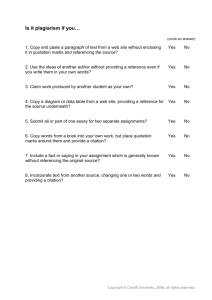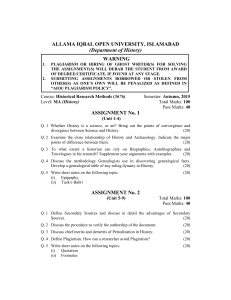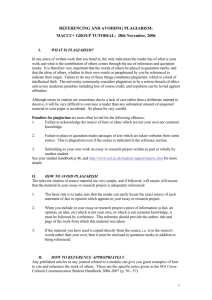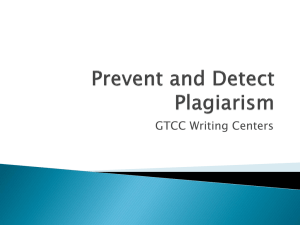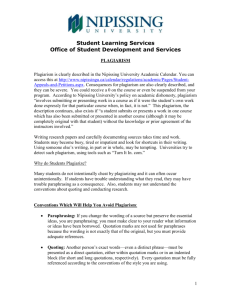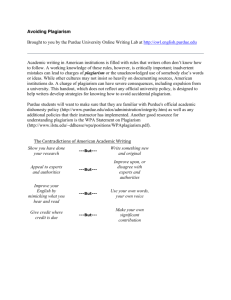Academic Integrity Policy
advertisement
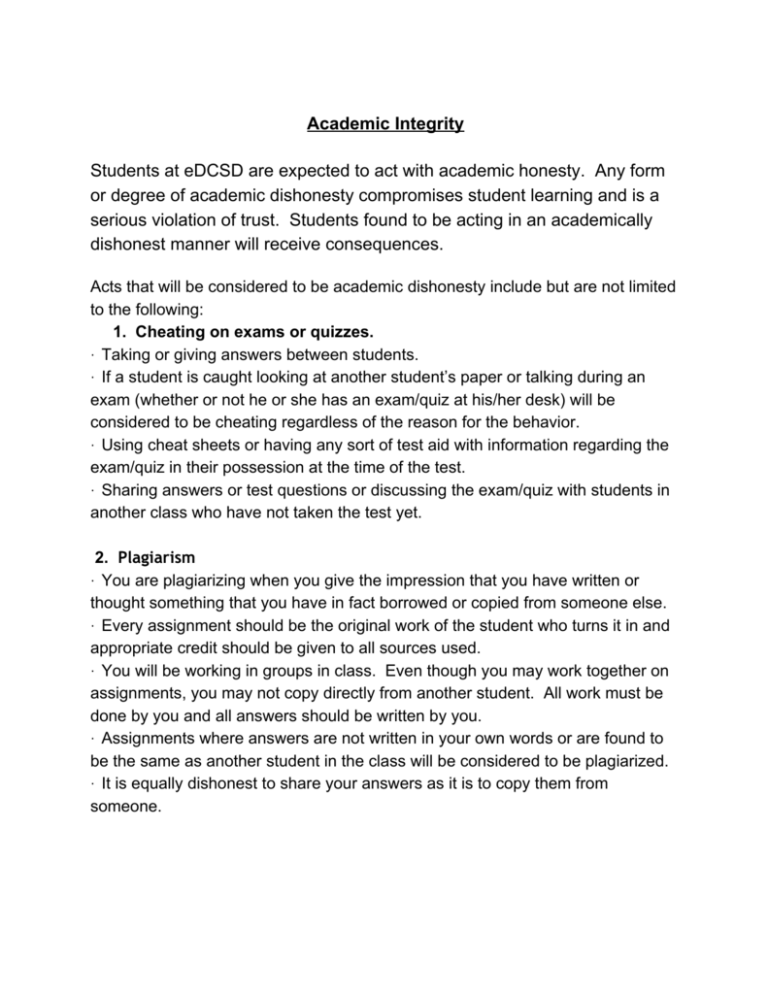
Academic Integrity Students at eDCSD are expected to act with academic honesty. Any form or degree of academic dishonesty compromises student learning and is a serious violation of trust. Students found to be acting in an academically dishonest manner will receive consequences. Acts that will be considered to be academic dishonesty include but are not limited to the following: 1. Cheating on exams or quizzes. · Taking or giving answers between students. · If a student is caught looking at another student’s paper or talking during an exam (whether or not he or she has an exam/quiz at his/her desk) will be considered to be cheating regardless of the reason for the behavior. · Using cheat sheets or having any sort of test aid with information regarding the exam/quiz in their possession at the time of the test. · Sharing answers or test questions or discussing the exam/quiz with students in another class who have not taken the test yet. 2. Plagiarism · You are plagiarizing when you give the impression that you have written or thought something that you have in fact borrowed or copied from someone else. · Every assignment should be the original work of the student who turns it in and appropriate credit should be given to all sources used. · You will be working in groups in class. Even though you may work together on assignments, you may not copy directly from another student. All work must be done by you and all answers should be written by you. · Assignments where answers are not written in your own words or are found to be the same as another student in the class will be considered to be plagiarized. · It is equally dishonest to share your answers as it is to copy them from someone. CONSEQUENCES FOR ACADEMIC DISHONESTY : First Offense of the School Year 1. Warning from teacher 2. Student given opportunity to redo assignment for full credit ­Timeline for makeup assignment at the discretion of the teacher ­ Grade will be recorded as a zero until the student resubmits assignment Second Offense of the School Year 1. Teacher will make contact with parents 2. May redo assignment for a maximum score of 50% ­Timeline for makeup assignment at the discretion of the teacher ­ Grade will be recorded as a zero until the student resubmits assignment Third Offense and All Subsequent Offenses of the School Year 1. Teacher will make contact with parents 2. Student will receive a zero for the assignment without the opportunity to make up the assignment for credit. 3. Academic Dishonesty referral to administrator. Understanding Plagiarism Adapted from a University of Phoenix Library Document What is Plagiarism? Plagiarism is presenting someone else’s ideas as your own. If you plagiarize, you are essentially committing literary theft. Plagiarism, whether accidental or intentional is a serious violation of the student code of conduct and carries significant consequences. Knowing what plagiarism is will help you create original individual work without worrying about possible penalties. Read the following examples carefully to understand those elements that constitute plagiarism. Examples of Plagiarism § Copying/paraphrasing directly from a source without using a citation or quotation marks. § Omitting a citation from information obtained from a source. § Rearranging words from a source without changing the majority of the content. § Copying information directly from the source with only minor changes to the wording. § Using phrasing or sentences that are too close to the original. § Changing only one or two words in a sentence without using quotation marks. § Copying and pasting information from an Internet source without including a citation or quotation marks. § Using images, charts, or graphics from a source without a citation. § Providing information about the source that is not accurate. What is not Plagiarism? When information is correctly summarized or paraphrased with an in­text citation and a reference at the end of the essay, it is not plagiarism. Using quotation marks with a direct quotation and a citation including page or paragraph number means the quotation has been correctly attributed to its source and is not plagiarized. If you use the following examples while writing your paper, you will be able to include sources in your work without accidentally plagiarizing. Examples of Correct Practices § Paraphrasing or summarizing information from another source that is correctly documented. This includes using a correct in­text citation and reference page entry. § Using quotation marks for words copied directly from a source and including a citation with page or paragraph numbers. § Copying information from an Internet source and using quotation marks and a citation, including page or paragraph number. § Using a citation for all information that is not common knowledge, including visual images, charts, and graphs. Common knowledge that most people know does not require a citation because it is known to general readers. Common knowledge should be written in your own words. What is Common Knowledge? Common knowledge consists of the following elements: 1. Information that is usually known to general readers 2. Information that is found in many places Example of Common Knowledge Common knowledge : George Washington was the first president of the United States [This is common knowledge because most people know that George Washington was the first president]. Not common knowledge : George Washington owned a distillery [Because this information is not known to the general public, a citation and reference list entry must be included]. The fact that George Washington owned and operated a distillery is not widely known; therefore, it is not common knowledge and must be cited. Types of Plagiarism Plagiarism can be accidental or intentional, but the consequences are the same. The student’s responsibility is to check each paper carefully to ensure that all direct quotations and ideas that are not original are correctly cited and referenced. As you will see from the following information, some types of plagiarism can be either accidental or intentional. Examples of Accidental Plagiarism § Copying a quotation without using quotation marks. § Eliminating a citation for information that comes from a source. § Using vague or incorrect citations. § Paraphrasing information incorrectly. § Writing material very close to the original—changing only a few words by using synonyms. § Copying and pasting a source from the Internet without using quotation marks or citations. Examples of Intentional Plagiarism § Eliminating a citation for information that comes from another source. § Using an incorrect citation so that the reader cannot locate the source. § Using another student’s work as your own. § Purchasing an essay from an Internet website. § Using an essay from a free Internet website. § Copying a quotation without using quotation marks. § Writing material very close to the original—changing only a few words by using synonyms. How to Avoid Accidental Plagiarism Plagiarism, either accidental or intentional, usually begins at the note taking stage of the writing process. If information is plagiarized in your notes, it can easily be transferred into plagiarized material in your final paper. You can eliminate accidental plagiarism by taking careful notes and giving credit for other people’s words and ideas, statistical information, graphics, or drawings. You can eliminate intentional plagiarism by being ethical and honest and allowing enough time for researching and writing an assignment. Use the following rules to eliminate plagiarism while taking notes and writing papers: Strategy One: When Taking Notes § Allow time for research. § Write the information from the source in your own words as you take notes. § Copy words directly from the source only if you want to quote the passage in the paper. § Use quotation marks for anything copied directly from a source. § Use wording in your notes that is different from the wording in the source. § Include the name of the source and page or paragraph numbers so that you won’t need to return to the source later to locate a missing page number, etc. § Include all pertinent information from the source to use in the reference list at the end of the paper. § Check your notes to be sure quotation marks have been used with all direct quotations. § Include page numbers of the quotations in your notes. § Include all information to be used in the reference list. § Include the page numbers of journal articles in your notes. § Include the page numbers of an article in an edited book in your notes. Strategy Two: When Writing Papers § Allow time for writing. § Create an outline to follow before beginning to write the paper. § Write the paper from your notes rather than from the original source. If you write the paper from the source, be sure to close the source or create a blank screen as you write. § Write the information from the source in your own words as paraphrased material. § Avoid referring to the source as you write or you will certainly use some of the original writer’s words. § Use quotation marks in your notes to indicate anything that is a direct quotation from a source. § Include citations as you are writing instead of going back to fill them in when the paper is finished. § Fill in material from the sources with your own ideas. § Check the source to be sure direct quotations have been copied accurately. § Check the source to be sure page or paragraph numbers are correct. Apollo Group. (2008). Grammar and writing guides: Plagiarism . Retrieved from https://ecampus.phoenix.edu/secure/aapd/grammar/plagiarism/typesofplagiarism.asp and https://ecampus.phoenix.edu/secure/aapd/grammar/plagiarism/understandingplagiarism.asp
